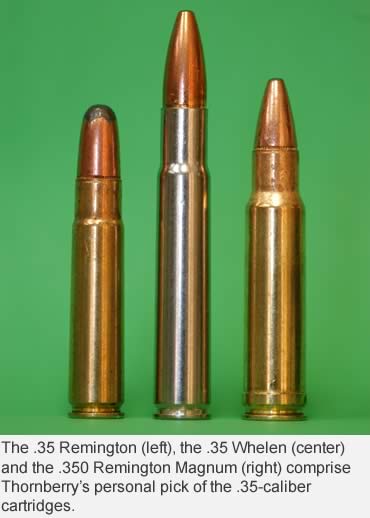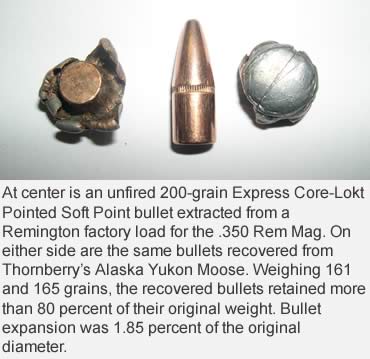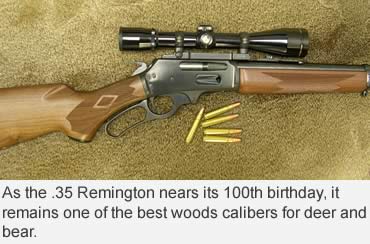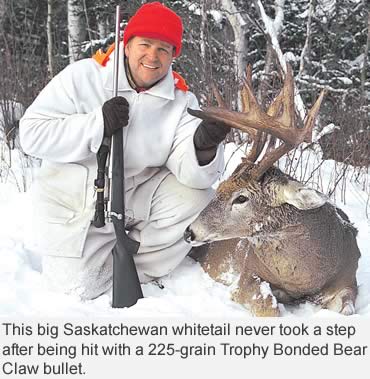The .35 Whelen, .35 Remington and .350 Rem Mag are the ultimate woods calibers.
There were numerous .35-caliber rifle cartridges born in the 20th century, but most of them didn’t live to see the dawning of the 21st century. Surviving .35-caliber cartridges introduced as factory offerings include the .35 Remington (1906); .356 Winchester (1980); .358 Winchester (1955); .35 Whelen (1987); and .350 Remington Magnum (1965).
The list of now-obsolete .35s includes the .35 Winchester Self-Loading (1905); .351 Winchester Self-Loading (1907); .350 Griffin & Howe Magnum (early 1930s); .35 Winchester (1903); .35 Newton (1915); .358 Norma Magnum (1959); and the .350 Remington Magnum (1965).
The .350 Remington Magnum is the only cartridge that appears on both lists of current and obsolete calibers. This is because it was discontinued in the mid-1970s, and reintroduced by Remington in 2003. That year, Remington also brought out the Model 673 Guide Gun in .350 Rem Mag. It’s a refined version of the quick-handling Model 600 and 660 guns that were highly prized by guides. I hated to see those rifles go, and I snapped up the first Model 673 I could get when it was reintroduced. I believe that in 1965, Remington’s .350 Mag was a cartridge ahead of its time.
Of the .35-caliber cartridges that are still available, three are standouts: .35 Remington, .35 Whelen and.350 Rem Mag.
The .35 Remington has proven itself for almost a century as a reliable short-range woods cartridge for medium-sized game such as deer and black bear. It has far more knockdown power than the .30-30 under any conditions at any range. Although its velocity and energy figures are comparable to the .30-30 on paper, the heavier bullet produces greater shock and a larger wound channel.
 Since the .35 Remington is a light-recoil cartridge, it is ideal for youngsters, even in light rifles, and undoubtedly the low recoil and short case length are what make it so popular in handguns. The Marlin 336 is the only production rifle still offered in .35 Remington.
Since the .35 Remington is a light-recoil cartridge, it is ideal for youngsters, even in light rifles, and undoubtedly the low recoil and short case length are what make it so popular in handguns. The Marlin 336 is the only production rifle still offered in .35 Remington.
One hundred and fifty yards is about maximum range for the cartridge, but for close-range woods hunting for whitetails, I see no reason to punish myself with bigger thunder. For its size, it packs all the punch needed for deer or black bear hunters.
Remington, Winchester and Federal still offer factory loads in 150- and 200-grain soft-point bullets. Expect a muzzle velocity of 2,300 feet per second from the 150-grain bullet, and 2,080 fps from the 200-grain from Marlin’s 336-C. These two bullets produce a muzzle energy of 1,765 foot-pounds and 2,080 foot-pounds respectively, and in both cases maintain plenty of knockdown power out to 150 yards. For hunting at longer ranges, Hornady offers its 200-grain FTX LeverEvolution load in .35 Rem.
For treestand or close-range blind hunting for whitetails, I love the .35 Remington. The fast-handling Marlin 336-C, with or without a scope, is my idea of the perfect close-up whitetail rifle.
In 1965, when the .350 Remington Magnum was introduced in the lightweight, short-barreled little Model 600, its 18-inch barrel made it a pick among guides all over the North, especially where dangerous bears were involved. In 1968, Remington lengthened the barrel to 20 inches, which added a modest increase in velocity. It still handled fast, and, with its factory-loaded 200-grain soft-point bullet leaving the muzzle at 2,710 fps, it delivered 3,261 foot-pounds of energy and packed a knockout punch sufficient to deck the largest critters in North America.
 The Model 600 wasn’t the prettiest rifle that ever hit the market, but it sure was practical. I was guiding bear hunters back in the early ’70s, and my little .350 was light and short enough to hold in one hand as I parted the alders with the other while tracking wounded bears or moose. It was simply a handy tool for the job. One shot ended the search on the spot. Naturally I was disappointed when, in the mid-1970s, the caliber became obsolete and reserves of ammo dried up.
The Model 600 wasn’t the prettiest rifle that ever hit the market, but it sure was practical. I was guiding bear hunters back in the early ’70s, and my little .350 was light and short enough to hold in one hand as I parted the alders with the other while tracking wounded bears or moose. It was simply a handy tool for the job. One shot ended the search on the spot. Naturally I was disappointed when, in the mid-1970s, the caliber became obsolete and reserves of ammo dried up.
I was sold on the punch of that .35-caliber 200-grain bullet, so in the absence of the .350 Rem Mag, I explored the .35 Whelen as a replacement. At that time, the Whelen had not yet been offered as a factory cartridge. But since it was based upon the popular .30-06 case, assuring the availability of brass for hand-loading, many hunters, myself included, were having rifles built for this hard-hitting wildcat. Then in 1987, Remington took the .35 Whelen from wildcat to factory cartridge, and it immediately gained a huge following.
Remington offered 200- and 250-grain loads for the Whelen, and since I had been so satisfied with the 200-grain bullet in my .350 Rem Mag, I assumed that would suit me as well in the Whelen. However, I was surprised at the performance of the 200-grain pointed soft-point bullets when I first used them on whitetails in Saskatchewan. They created tennis ball-sized entry holes but no exits.
The bullets appeared to blow up on impact, although they did drop the several bucks I shot with them. In spite of that, I was bothered by the large entry wounds and lack of exits. My only other option at the time was the 250-grain pointed soft point, which was a heavier bullet than I wanted to shoot at deer. About that time, Federal began manufacturing ammo for the Whelen. They offered a premium cartridge loaded with a 225-grain Trophy Bonded Bear Claw bullet, and my search for the right bullet was over. Since then, I have taken whitetails, Alaska moose and numerous bears with that bullet, and they have all been one-shot kills. In almost every case, the animals were knocked off their feet upon impact.
 The Federal Premium 225-grain cartridge generates a muzzle velocity of 2,610 fps from my Model 700 Remington rifle with a custom 22-inch barrel, and delivers a devastating 3,375 foot-pounds of energy at the muzzle. Little wonder it is so lethal on even the biggest big game. In my opinion, it’s the perfect bullet for the Whelen.
The Federal Premium 225-grain cartridge generates a muzzle velocity of 2,610 fps from my Model 700 Remington rifle with a custom 22-inch barrel, and delivers a devastating 3,375 foot-pounds of energy at the muzzle. Little wonder it is so lethal on even the biggest big game. In my opinion, it’s the perfect bullet for the Whelen.
When comparing the ballistic capabilities of the .35 Whelen with the .350 Rem Mag, the differences are largely academic in terms of their potency on big game. However, there are some differences that might hold some sway for a hunter trying to decide on one or the other. First, the .35 Whelen is a long-action case, while the .350 Rem Mag is a short-action case. One could argue that the shorter action equates to a lighter-weight rifle.
Conversely, the longer case of the .35 Whelen does offer the user the benefit of heavier bullets, up to 250 grains, and even heavier bullets if reloading is an option. The .350 Rem Mag, like all short-action cartridges, must seat longer, heavier bullets deeper in the case to avoid exceeding the maximum case length, sometimes critically reducing needed powder volume.
 After shooting the Federal 225-grain Trophy Bonded Bear Claw bullet in my .35 Whelen, I assumed it had an edge over the .350 Rem Mag for moose and grizzly because of its heavier bullet capacity. However, I shot a huge bull moose in the Yukon with the .350 Rem Mag, using Remington’s 200-grain Express Core-Lokt Pointed Soft Point factory ammo. I was pleasantly surprised to see how these bullets penetrated, expanded and held together. I had a narrow opening in some thick alders to shoot through, with only a portion of the bull’s neck in open view. He hit the ground like a sack of hammers upon impact. I used a second shot at point-blank range to finish the job, but the bull was fully immobilized with the first shot.
After shooting the Federal 225-grain Trophy Bonded Bear Claw bullet in my .35 Whelen, I assumed it had an edge over the .350 Rem Mag for moose and grizzly because of its heavier bullet capacity. However, I shot a huge bull moose in the Yukon with the .350 Rem Mag, using Remington’s 200-grain Express Core-Lokt Pointed Soft Point factory ammo. I was pleasantly surprised to see how these bullets penetrated, expanded and held together. I had a narrow opening in some thick alders to shoot through, with only a portion of the bull’s neck in open view. He hit the ground like a sack of hammers upon impact. I used a second shot at point-blank range to finish the job, but the bull was fully immobilized with the first shot.
If I were going to walk long distances or backpack hunt, I’d pick the .350 Rem Mag because it weighs about a pound less than my Whelen, and it has a shorter barrel.
But for the difference of a pound, who really cares? Of this, I am sure: Both calibers are awesome and devastating on game from deer to moose. Unless extremely long-range shooting range is required, I’d pick them over some of the extremely fast .300 Magnums for much the same reasons that professional hunters in Africa prefer heavier bullets at slower speeds on heavy game than the explosive speedsters. Deep penetration and controlled expansion are the issues.
In my three-rifle collection of .35s, the .35 Remington, .35 Whelen and the .350 Remington Magnum are permanent fixtures.
Read Recent GunHunter Articles:
• Going Full Bore: They may not be as accurate or flat-shooting as saboted slugs, but wide-bodied slugs continue to dominate the slug market.
• Four-Gun Battery for Life: Choose carefully, and you’ll be equipped to hunt any game anywhere in the world with just a few rifles.
This article originally appeared in the April 2004 issue of Buckmasters GunHunter Magazine and has been updated. Subscribe today to have GunHunter delivered to your home.